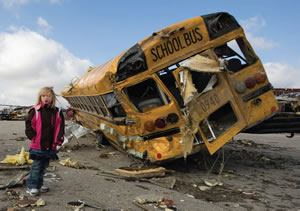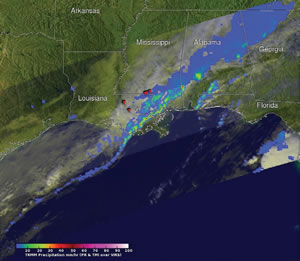A Primer: Natural Disaster and Preparation
- By Stephen Satterly
- 05/01/14

PHOTO BY DVIDSHUB
On May 20, 2013, near the end of another long school day; and just before the children would be lining up to board their buses, stepping out front to meet their parents or walking home to play, the world changed for the students and staff of Plaza Towers Elementary School in Moore, Okla., as nature’s hand interceded.
At 2:56 p.m., a tornado touched down in New Castle, just west of Moore, and within 39 minutes it had traveled 17 miles, growing to a massive 1.3 mile-wide EF-5 monster. With winds exceeding 210 mile per hour, this unyielding force of nature turned Plaza Towers Elementary School into a pile of rubble with teachers and students trapped underneath.
Seven students, eight- to nine-years-old, were found dead in one of the classrooms. Initial reports were that they drowned, but the state’s medical examiner’s office found that six students were asphyxiated, and one was killed by blunt-force trauma.
An EF-5 tornado is one of the most devastating natural disasters a school can face, but it is not the only one. Wildfires, mudslides, earthquakes, lightning,
hurricanes — there are numerous ways for the Earth to provide a threat to a school. Some schools have found it easy to focus on active shooter incidents. With 62 people killed in 22 K-12 active shooter incidents since 1998, they certainly provide a major impact to a community. However, in terms of the number of incidents and the amount of property damage done, Mother Nature takes a back seat to no one.
School administrators and safety professionals would be prudent to assess the risk of natural disasters to their schools, and to develop, then practice, plans and protocols used to prepare and respond to them.

PHOTO © BY NASA GODDARD PHOTO AND VIDEO
Risk assessment
Risk assessment is a process to identify potential hazards and analyze what could happen if a hazard occurs. Schools should use this process to identify the natural hazards they may face, identify vulnerability targets of those hazards, as well as the impact of the losses the school could face.
Hazard identification
Identifying hazards is a local activity. A hazard for the county may not be a hazard for the school, so school officials need to focus on their school. They should also seek the assistance of their local emergency management director and local first responders.
Data on hazards can be found at various sources. The National Oceanic and Atmospheric Administration (NOAA) is a good source for hurricane data. The National Weather Service and Storm Prediction Center provides the best data on tornadoes, lightning and other weather-related phenomena. The National Geologic Survey is an excellent source for earthquake data. Between these sources and the input of local experts, school officials should be able to identify the various hazards their schools may face.
Once a hazard has been identified, it should be analyzed for probability and magnitude. For example, in Indiana the damage from a hurricane would be of high magnitude, but it would be of low probability. Thus it would not be prudent to plan for hurricanes in Indiana. Thunderstorms can create damage. In Indiana the probability of them happening is high, especially during warm weather. However, the damage they cause is usually light, with the greatest danger being from lightning. Consequently few Indiana schools have thunderstorm protocols.
Vulnerability targets
Vulnerability targets are who, or what will be harmed by a disaster, with injuries to people being a priority. Physical assets may be at risk as well. These include school buildings, infrastructure and utility systems.
Vulnerabilities include building construction deficiencies, and gaps in security and protection systems. They contribute to the severity of damage when a disaster occurs. A building without a fire sprinkler system could burn to the ground while a building with a properly designed, installed and maintained fire sprinkler system would suffer limited fire damage.
Impact analysis
Impact refers to the loss of valued assets. It includes casualties, property damage, loss of business continuity, financial loss and lawsuits. An impact analysis should include methods to reduce the impact, called mitigation. The fire sprinkler system mentioned above is an example of mitigation.
Plan development
Plans should be made that mitigate or respond to the identified risks. These plans have to take into account the various stakeholders that will be affected by them, and should be specific to those stakeholders. Just as plans are school-specific, they should also be stakeholder-specific. The plans should also include any protocols to be used.
Stakeholders
Identifying stakeholders is the first step in the planning stage. Stakeholders have a personal interest in the outcome of a plan. A school’s stakeholders are students, teachers, administrators, staff, parents, the community and anyone else the school officials determine have an interest in the outcome. Good plans will have components specific to each stakeholder. The plans for teachers should be different than those for administrators, and their plans should be different from the plans for custodians, cafeteria workers or front office personnel.
Protocols
A protocol is a set of standardized procedures for responding to a specific disaster. Standardized procedures allow for easier recall under intense stress. They provide a common base of training for all stakeholders. They do not cover all possibilities, and like military plans, they will often not survive first contact intact. They do, however, provide you with a starting point, and having a well-planned protocol is much better than not having a plan at all.
Exercising the plan
Once the plan is created, it should be practiced. The practice needs to occur regularly, as part of a robust, progressive exercise regimen. Practicing the plan strengthens the stakeholder’s ability to implement the plan. It also identifies flaws in the plan, allowing any deficiencies to be addressed in a relatively low-stress situation prior to their use in a disaster.
Orientation seminars
An orientation seminar is an overview or introduction to an emergency plan. It allows participants to become familiar with roles, plans, procedures or equipment. The seminar can also be used to assign responsibilities. Schools will typically have the orientation seminar at the beginning of the year.
Drills
The purpose of a drill is to practice one small part of the emergency plan. It typically does not involve coordination with other stakeholders. The drill should focus on a single, relatively limited portion of the overall emergency plan. Fire drills in schools most often focus on the evacuation of the school in a timely manner.
Tabletop exercises
A tabletop exercise is an informal exercise that should occur in a relatively stress-free environment. It is a discussion between participants who examine and resolve problems with their emergency plans. In schools, the tabletop exercise is the bread and butter of emergency planning. The research of Dr. Gary Klein has shown that frequent scenario-based training deepens the base of knowledge a person uses to make decisions during a crisis.
Schools can do this at team meetings, staff meeting, central office cabinet meetings and any other time educators gather together. It takes mere moments to describe a realistic scenario and then ask, “What would we do?” This type of exercise has the added benefit of creating “buy-in” of school staff, increasing the likelihood the procedures will be used in an actual disaster.
Functional exercises
A functional exercise is a simulated, interactive exercise that tests a school’s capability to respond to a simulated disaster. Functional exercises test multiple functions of the school’s emergency plan and their coordination with responding agencies.
A school district can use a functional exercise to practice a school’s ability to receive a bomb threat, process it with the local 911 call center, then employ their protocol.
Schools operate under the constant threat of natural disaster. The innocent children in the school provide a critical vulnerability that should motivate any school to create a viable plan, and prepare that plan for implementation.
The two keys to a viable plan are a good risk assessment and a robust exercise program. Identifying local hazards help schools determine vulnerabilities, and the impact of a natural disaster on their vulnerability targets, especially their people. Risk assessment is therefore one of the most important safety activities a school can do.
Schools must develop a natural disaster plan and then develop a progressive exercise plan to practice their responses. Use realistic, scenario-based tabletop exercises to deepen the base of knowledge of the staff in emergency response, and coordinate with first responders and the local emergency management agency in all phases of the process.
Nothing can be done to stop an EF-5 tornado from slamming into a school like Plaza Towers Elementary School, but with risk assessment and exercise planning, schools can make it more likely that they will be pulling live children from the rubble, not recovering lifeless bodies.
With the stakes so high, what will you do?
This article originally appeared in the issue of .